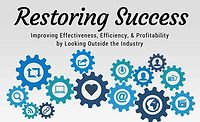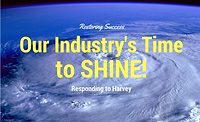Restoring Success: Efficiency in our Movements

Imagine a fire truck pulling up to a home. It is clean, organized, and the firefighters move with confidence as they seem to each know exactly what their job is and where everything is located to get the job done. I asked my coworker who has been a firefighter for nearly 20 years about the efficient and effective movements of the firefighters as they arrive on scene. He confirmed that it is deliberately designed this way and they are trained accordingly. Even the firetruck seats have numbers which are tied to their duties when arriving on scene.
We may have some work to do to arrive on the scene of a water loss and move like firefighters; however, it is a wonderful vision to work toward. There is much to learn by Looking Outside the Industry. Consider the findings of UPS, a company which has made efficiency in movement a focus of their organization. According to UPS data guy Jack Levi, "just one minute per driver per day over the course of a year adds up to $14.5 million." Levis says they are constantly looking at data to figure out how to do things better, and faster. And, he says, the drivers benefit from that along with the company, which is why they are the highest paid in their industry - and Levis understands it's his job to keep it that way. Check out the entire article, To Increase Productivity, UPS Monitors Drivers' Every Move.
Where do we begin in the restoration industry?
- Make it part of our culture: Like so many aspects of our organization’s attributes, efficiency can be part of our culture. Talk about efficiency and consistently identify and resolve inefficiency. Reward and recognize efficiency in the operations and those who lead and inspire it in others.
- Incorporate it in our process designs, developments, and general operations: Constantly develop with the concept and thought of optimal efficiency in achieving objectives.
- Include it in our training programs: When training, incorporate the concepts of efficiency in our deployments and rendering of services.
When we execute our work, there are typically objectives that relate to the quality of our services and the satisfaction of those we are serving. Jobs must also be executed within some profitability range. Efficiency in our movements can give us improved profitability on our jobs and lend itself to improved consistency in the quality of our work. There are great benefits to the company and the individual team members as noted by UPS.
Efficiencies can be gained in many ways including the employment of technology, equipment, and products. The following is a short list specifically focused on our movements. Take a step back observe, and consider the reducing of steps, minutes, and movements:
-
Warehousing and General Organization: Observe the deployment of the team in the morning and or an emergency service. Consider how long does it take to find and gather the necessary supplies and equipment.
- Things that are most frequently used are organized and most accessible
- Appropriate inventory levels for daily operations are maintained
- Vehicle Design and Organization: Once we arrive on scene, are we most efficiently unloading and locating all necessary supplies, equipment, and tools.
-
Preparation and Lists: Preparing supply lists and having standardized lists for our most routine job types: structure cleans, water losses, and mold remediation. To name a few will keep us moving on the job.
- This will help minimize supply runs! Imagine a drywall patch. We don’t have our joint tape. We stop, go to the store, go back to the job, and restart our work. How much time is lost from a lack of preparedness? Not only did we stop our work rhythm; we walked to the car, drove to the store (more vehicle expense), bought the $7 roll of tape, drove back to the job, figured out where we left off, and got started again. HOURS!? What if there were two people together who did this? (This is a dramatization for effect…ha-ha!)
- Evaluate your Standard Operating Procedures. Adherence to lists and SOPs in our deployment can go a long way. Consider an emergency deployment and we need something as simple a broom. We forgot a broom. We have a dustpan but no broom. You go to use the shop vac and discover it does not work. Now what? Quality and/or efficiency may take a major hit on just this one job.
- Leadership and Workflows: In our industry, we are faced with ongoing unique situations and jobs. Every execution from a water loss to the restoration of contents can be approached with a leader directing activities and the teams to move in not only the most technically proficient manner but also the most efficient manner. When we challenge ourselves to evaluate and consider deployment that is not only effective but also done with the least amount of movement, we can dramatically improve our efficiencies in our day to day.
Take a step back, observe the team’s movements. How often are we needlessly touching or moving something? How often do we look for something? How much time is being wasted unnecessarily in additional steps or needing something? Is there ever a team member standing and doing nothing, maybe waiting for direction? The opportunities to improve efficiency may be endless. Take advantage of them today.
Happy Restoring Success Efficiently.
Looking for a reprint of this article?
From high-res PDFs to custom plaques, order your copy today!






